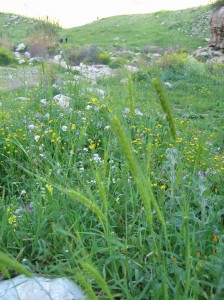
Exodus 9:31, The barley was in the head. Barley was cultivated as a grain crop in ancient Egypt, as well as in Israel, and grows wild like a weed throughout the region to this day. Several passages in the Scriptures witness to the fact that the barley was the indicator of which month was to be the first month of the year for the Israelites, so that they could determine when the biblical feasts were to be observed.
Observe the month of Abib, and keep the Passover unto YHVH your Elohim: for in the month of Abib YHVH your Elohim brought thee forth out of Egypt by night. (Deut 16:1, emphasis added)
Please notice, the definite article the proceeding the phrase “month of Abib.” The state of the barley determined the name of a specific month in the spring on YHVH’s biblical calendar. Months in the biblical Hebrew calendar have always been determined by the first visible sliver of the new moon from antiquity. This specific month is to be the beginning the biblical new year (Exod 12:2). The state of the barley simply determines which month is to be the first month of the biblical year. The month of the Abib is not so much the name of a monthas it is a description of the month. Below are listed the other three places in the Scriptures where this phrase is found.
This day came you out in the month Abib. (Exod 13:4)
You shall keep the Feast of Unleavened Bread: (you shall eat unleavened bread seven days, as I commanded thee, in the time appointed of the month Abib; for in it you came out from Egypt: and none shall appear before me empty). (Exod 23:15)
The feast of unleavened bread shall you keep. Seven days you shall eat unleavened bread, as I commanded you, in the time of the month Abib: for in the month Abib you came out from Egypt. (Exod 34:18, emphasis added on all)
What does the word abib in the phrase “the month of the Abib (or Aviv)” mean? The Hebrew word abib is found only six times in the Bible and is transliterated into the English (in the KJV) as “abib,” meaning “in the ear,” or “green ears of grain.” The Theological Wordbook of the Old Testament, defines the word abib or aviv as follows:
This noun refers to barley that is already ripe, but still soft, the grains of which are eaten either rubbed or roasted. The ASV and RSV agree (but see Lev 2:14). The seventh plague brought ruinous hail upon Egypt’s barley crop at least two weeks before it was fully ripened and ready for harvest (Exod 9:31). Abib was also the early name (later, Nisan) of the first month of the Jewish calendar (the month of Passover). In that month the barley came to ear, but the usual time of harvest was the second month (Iyyar). According to Lev 2:14 the grain offering was to consist of the firstfruits of abib.
So the barley being in its abib state eliminates the guesswork of determining which new moon begins the new year. The Scriptures are clear. It is the new moon that immediately follows the abib barley that determines the beginning of the year. This is important to know, since knowing the start of the new year determines the dates for the biblical moedim or appoint times—namely the biblical holidays and feasts.
After the abib barley is found and the first visible sliver of the new moon is sighted marking the first day of the first month of YHVH’s biblical calendar, 14 days later is Passover (Pesach) with the Feast of Unleavened Bread (Chag HaMatzot) immediately following on the fifteenth day of the first month. Then on the day after the weekly Sabbath that occurred during the seven-day Feast of Unleavened Bread, a sheaf of now-ripened barley was cut and waved heavenward by the high priest to be accepted by YHVH as the first of the first fruits offering of the upcoming barley harvest. I have written extensively on this subject in another teaching article relating to the spring feast days, which can be found on our website. Suffice it to say that the barley that was lifted heavenward and waved was a prophetic picture of Yeshua the Messiah’s ascension to heaven after his resurrection where he was accepted by the Father as the perfect sin offering covering the sins of mankind. Fifty days later to the day is the Feast of Pentecost (Heb. Shavuot) picturing the ripening of the larger wheat harvest, which was a prophetic picture of all Israel and the peoples of the nations coming to faith in Yeshua from the first century until the present time. As you can see, an understanding of the abib barley is essential not only in setting the biblical calendar for the year, but for knowing when to keep the biblical feasts, and for gaining a fuller understanding of the salvific implications of the death, burial and resurrection of our Master and Savior, Yeshua the Messiah from a Hebraic perspective.
For more information on the biblical calendar and the waving of the barley first fruits see http://www.hoshanarabbah.org/pdfs/cal_demyst.pdf; http://www.hoshanarabbah.org/pdfs/new_moons.pdf; http://www.hoshanarabbah.org/pdfs/firstfruits.pdf.



